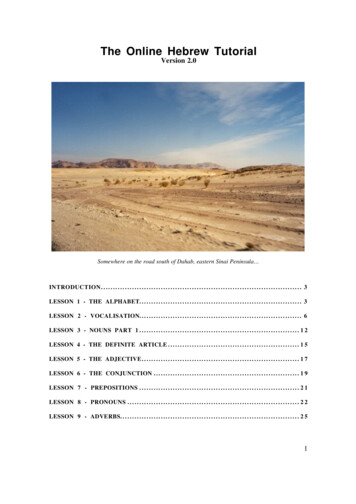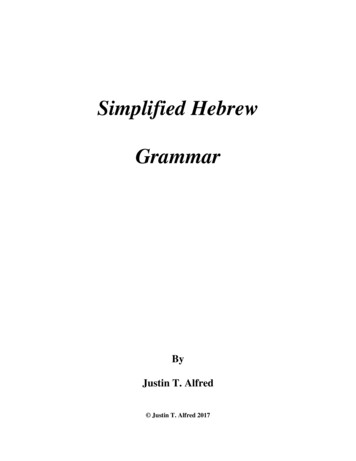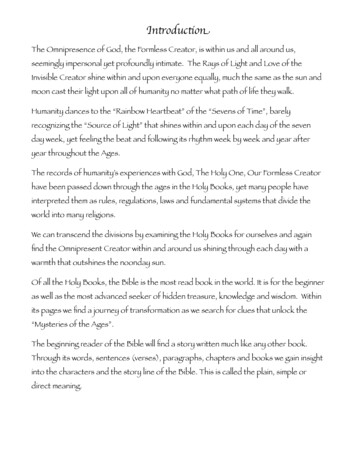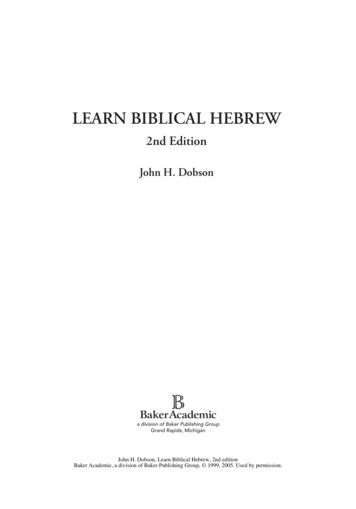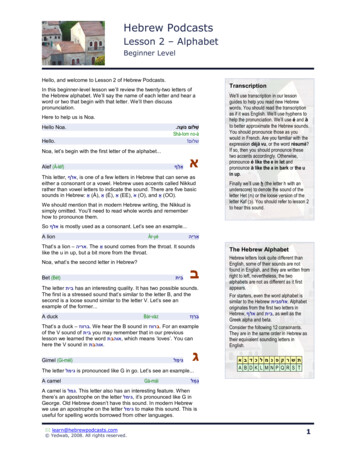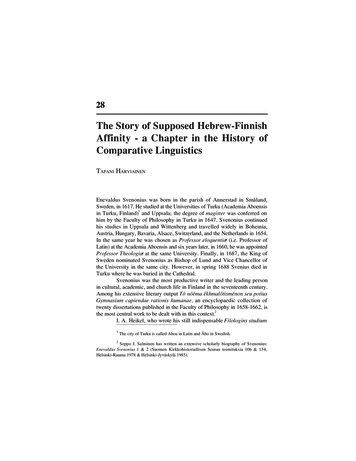
Transcription
28The Story of Supposed Hebrew-FinnishAffinity - a Chapter in the History ofComparative LinguisticsTAPANI HARVIAINENEnevaldus Svenonius was born in the parish of Annerstad in Småland,Sweden, in 1617. He studied at the Universities of Turku (Academia Aboensisin Turku, Finland)1 and Uppsala; the degree of magister was conferred onhim by the Faculty of Philosophy in Turku in 1647. Svenonius continuedhis studies in Uppsala and Wittenberg and travelled widely in Bohemia,Austria, Hungary, Bavaria, Alsace, Switzerland, and the Netherlands in 1654.In the same year he was chosen as Professor eloquentiæ (i.e. Professor ofLatin) at the Academia Aboensis and six years later, in 1660, he was appointedProfessor Theologiæ at the same University. Finally, in 1687, the King ofSweden nominated Svenonius as Bishop of Lund and Vice Chancellor ofthe University in the same city. However, in spring 1688 Svenius died inTurku where he was buried in the Cathedral.Svenonius was the most productive writer and the leading personin cultural, academic, and church life in Finland in the seventeenth century.Among his extensive literary output Tò nóe ma e khmalo tisménon seu potiusGymnasium capiendae rationis humanae, an encyclopaedic collection oftwenty dissertations published in the Faculty of Philosophy in 1658-1662, isthe most central work to be dealt with in this context.2I. A. Heikel, who wrote his still indispensable Filologins studium1The city of Turku is called Aboa in Latin and Åbo in Swedish.2Seppo J. Salminen has written an extensive scholarly biography of Svenonius:Enevaldus Svenonius 1 & 2 (Suomen Kirkkohistoriallisen Seuran toimituksia 106 & 134,Helsinki-Rauma 1978 & Helsinki-Jyväskylä 1985).
290 / THE STORY OF SUPPOSED HEBREW-FINNISH AFFINITYvid Åbo universitet (‘The study of philology at the University of Åbo’) in1884, includes the following statement in his presentation of Svenonius (p.57): “As far as is known, even the questionable merit of being the first topropose the sentence that to the greatest extent the Finnish language has3received its vocabulary from Greek and Latin, rests with Svenonius.” As arule, a similar amused tone accompanies the descriptions of the linguisticachievements of Svenonius and his colleagues of the seventeenth andeighteenth centuries in both scholarly and popular works, inclusive oftextbooks.4Indeed, Svenonius wrote in Tò nóe ma e khmalo tisménon seu potiusGymnasium capiendae rationis humanae (Book 5, Para. XLIII, p. 87) that“Finnicæ lingvæ originem quod concernit, videtur ea maximam esse partemex Græcis & Hebræis generata vocabulis” (‘concerning the origins of theFinnish language, it seems to originate to the greatest part from Greek andHebrew words’). As examples to prove his statement, he first refers tothirteen Greek words and proper names with their supposed counterparts inFinnish: Greek khaláo , Lat. demergo, ‘to sink, submerge’ Finnish Kala,Lat. piscis, ‘a fish’; Greek khei los, Lat. labium, ‘a lip’ Finnish kieli Lat.lingva ‘a tongue’; Greek kho iros, Lat. porcus, sus, ‘a pork, pig’ Finnishkoira, Lat. canis, ‘a dog’; Greek aigésippos, ‘Hegesip’ Finnish Sippi;Greek basilios Rus[sian, sic !] Wasiliwitz &c.In contrast to Greek,5 “the Hebrew vocabulary of Finnish” presented3“Svenonius tillkommer äfven den tvifelaktiga förtjänsten att, så vidt man vet,först ha uppstält den satsen, att finskan till största delen har sina ord från grekiskan ochhebreiskan”, I.A. Heikel, Filologins studium vid Åbo universitet (Åbo universitets lärdomshistoria,5. Filologin. Skrifter utgifna av Svenska Literatursällskapet i Finland, XXVI. Helsingfors1894, p. 57); Svenonius and his linguistic views are described by Heikel on pp. 51-62, whilelater proponents of the Hebrew background of the Finnish language are introduced on pp.149-151 and 208-212.4See e.g. Salminen’s summary of the philological parts of Svenonius’ work andhis sources: Baazius, Scaliger, Beckmann, Glandorp, Walther, Walper, etc.; for the discussionof the Hebrew-Finnish relations Salminen has been unable to find earlier sources (Salminen1978: 238-260).5Still in 1774 Nils Idman defended the community (gemenskap) of the Greek andFinnish languages with a reference to hundreds of similar words in his extensive work Försökat wisa gemenskap emellan finska och grekiska språken, såsom tjenande till uplysning i finskafolkets historie written in Swedish (Åbo 1774, 92 pp.) which in 1778 also appeared in Frenchtranslation in Strasbourg (Recherches sur l'ancien peuple finois, d'après les rapports de lalangue finoise avec la langue grecque, par M. le pasteur Nils Idman, ouvrage traduit dusuédois par M. Genet le fils, Strasbourg: Bauer et Treuttel, 1778, xvi 149 pp.).Similarly, still in 1770 Nicolaus Funck defended the close relation of Swedish toGreek in his dissertation De harmonia linguæ Græcæ & Sviogothicæ at the University of
TAPANI HARVIAINEN / 291by Svenonius, one of the first scholars of the local language of his universitytown, has - to the best of my knowledge - never been published in a formcomprehensible to a modern-day student of the history of linguistics whoseknowledge of Hebrew and/or Finnish may often be rather limited.6 Thus thefollowing decipherment may not be out of place in this collection; at thesame time it endeavours to provide the reader with an opportunity to realizewith the development that took place in the study of Hebrew-Finnish relationsduring the following century.Svenonius presents the 36 or 37 Hebrew words in a type of transcript,and their Finnish counterparts are not always easy to identify. In the listbelow I first give the genuine Hebrew spelling followed by the transcript ofSvenonius and then a transcript in a more systematic form based on theacademic pronunciation tradition current in those days (N.B.: ch [x], z [z], and ts the affricate [c]). The translations of the Hebrew words intoLatin provided by Svenonius are translated by me into English betweenbrackets; after an equation sign it is followed by the Finnish counterpart ofthe Hebrew word according to Svenonius (underlined by me and a fewtimes clarified with modern spelling / form between brackets). The translationsof the Finnish words by Svenonius into Latin (and a few times into Swedish)and their renderings from Latin into English, added by me between brackets,7complete the entries. A similar method of presentation is also applied inother vocabularies in this article. אבה Avah; ava; voluit (‘he wanted, wished’) åwi ( ovi) (in Swedish) döör(‘a door’) / q: ad nutum patens (‘opening according to wish’). אוי Oi; oy; Wæ (‘oh’) woi part. intendendi (exclamatory particle). אודות Odot; odot; causæ (‘on account of’) ådotta expectare & q: causasrimari (‘to wait, expect’ & ‘to search for reasons’). אם Em; em; mater (‘a mother’) Ämi ( ämmä) anus (‘an old woman’). איל Ajal, ail; ayal, ayil; ceruus, dux (‘a deer’, ‘a leader’), אילות Ejaluth;eyalut; fortitudo (‘power’) jalo præstans (‘excellent’). אכן Achen; achen; verè, profectò (‘surely’) niniken ( niin ikään) ita,propemodum (‘thus’, ‘similarly’).Uppsala; parallel ideas concerning the relation between German and Greek and French andGreek were proposed by well-known scholars till the end of the eighteenth century.6Both Heikel (1894: 56-57) and Salminen (1978: 240-241) quote a number ofGreek etymologies of Finnish words in Svenonius; however, the similar lists of the Hebrewvocabulary have remained beyond their scope.7In a number of cases Svenonius’ Latin equivalents of Finnish words are inaccurate;however, in this context these errors are irrelevant and are not corrected by me.
292 / THE STORY OF SUPPOSED HEBREW-FINNISH AFFINITY הולל Holel; holel / holal; vesanus (‘furious, madman’) hullu insanus (‘folly,infatuated’). חזה Chadsah; chaza; vidit (‘he saw’) katzo idem. חטב Chatab; chatav; cæcidit ligna (‘he cut firewood’) catawa ( kataja)juniperus (‘a juniper’). חלף Chalaph; chalaf; penetravit (‘he passed on, penetrated’) kelpa juvareq: opem insinuare (‘to help something to insinuate’). חמל Chamal; chamal; clemens f. (‘he had compassion’) camala mirabilis :clementia enim Dei quòd milliès superet justitiam mirari subit(‘surprising, awful : namely, the compassion of God which a thousandtimes exceeds the justice is surprising’). חמר Chamar; chamar; lutosus f. (‘was muddy’) camara pellis suilla, q:semper lutosa (‘pigskin which is always muddy’). חרמשׁ Chærmæsch; chermesh; falx messoria (‘a harvest sickle’) kermess ( kärmes, käärme) serpens, à simili figurâ (‘a serpent, from a similarshape’). חרפה Cherpah; cherpa; probrum (‘shame’), cui non dissimilitèr enunciaturmembrum virile (‘with which not dissimilarly the male organ iscalled’).8 ילך Ialach; yalach; ivit (‘he walked’, a theoretical verb which in practicedoes not occur in Hebrew) jalka pes (‘a foot, leg’). יפיח Iapheach; yafeach; efflavit, locutus est (‘it blew’, ‘he spoke’), & פוח poach; poach / puach; flare (‘to breathe’) poho, (Swedish) bläsa(‘to blow’) / puhu, (Swedish) tala (‘to speak’). עמנו אל Imanuel; imanu’el; anagrammatisthei s (‘God is with us’ with lettersin a different order) Jumalen : Jumala enim, quod Deum significat(‘God’s : God, which signifies God’).9 Svenonius continued bywriting that it is rather probable that Jumala should be derived fromHebrew יום Iom; yom; dies (‘a day’), & מלא Mala; mala / male;plenus f. (‘was full’), q: plenus dierum & annorum, ut significetidem quod infinitus & æternus (‘i.e. full with days and years tosignify Him who is infinite and eternal’).108With a tacit reference to the Finnish word kyrpä ‘penis’, not in polite use.9After this equation Svenonius adds that this etymology is preferable to that fromJulma (‘terrible’), which more probably is derived from Jumala (‘God’).10Svenonius goes on to argue that in Finnish the letter o is easily pronounced as[u]; the latter etymology accords well with the Scriptures, because God the Father is called theAncient of Days (Dan. 7,13. 22), and God the Son proceeds from ancient days (Micah 5,2),whose years will never end (Hebrews 2,12 [an error pro Heb. 1,12]). In plural Iom (day) refers
TAPANI HARVIAINEN / 293 כנס Canas; kanas; collegit (‘he collected’) Kansa ( kanssa) cum (‘with’). כר Car; kar, Camelus, agnus, aries (‘a camel’, ‘lamb’, ‘ram’) Karia, S[wedish]boskap, pecudes (‘cattle’). לישׁ Laisch; layish, Leo decrepitus (‘a decrepit lion’) Laiska piger (‘lazy’). נשל Naschal; nashal; solvit (‘he loosened, undid’) Nascala subula (‘acobbler’s awl’). סוס Sws; sus; 1. Equus 2. Grus, 3. Anser sylvestris, variorumquè aliorumanimalium nomen (‘1. a horse, 2. a crane, 3. a wild goose, and thename of various other animals’) Susi Lupus (‘a wolf’). סלה Silla; (theoretically) sil-la; stravit (‘he built a way’) Silla ( silta) pons(‘a bridge’). סלח Sallach; sallach; condonavit (‘he forgave’)11 salli permittere (‘to permit’). עלפה Ulpæ; ulpe;12 obtectus ore (‘with a mouth covered up’) ylpiä superbus(‘proud’). פורה Purah; pura; in quod uvæ confringendæ mittuntur (‘in which the grapesto be pressed are put’) Puro puls (‘a brook’). פימה Pimah; pima; omentum, pingvedo (‘the fatty membrane or caul coveringthe intestines’, ‘fatness’) Pimä pingvedo lactis (‘butterfat,buttermilk’). פסה Pissah; pissa; particula (‘a particle’)13 pissar ( pisara) guttula (‘asmall drop’). פרשׁ pæræsch; peresh; fimus æquiv. met. podex (‘manure, metonymicallyequal to the anal orifice’).14 צרע Tsara; tsara; leprosus f. (‘was leper’) sairas ægrotus (‘ill’). קדח Kadach; kadach; accendit, ferbuit (‘was kindled’, ‘glowed’) Kådas ( kota) culina (‘cooking hut’). קדים Kadim; kadim; ante pridem15 (‘in front, before’ and ‘in days of yore’) kodast ( kohdast kohdakkain) è regione (‘opposite’). קול Kool; kol; sonus (‘a voice, sound’) kuula audire (‘to hear’). ראה Raah; ra’a; vidit, providit, pavit (‘he saw’, ‘predicted’, ‘provided’, ‘wasto years; God the Holy Spirit proceeds from both eternities (i.e. the past and the future, TH)and he is the spirit of the veritable eternity (John 15,26; Ps. 33,6 & 119,90).11More correctly ‘ready to forgive’, occurs only in Ps. 86,5.12A corrupt word in Ezek. 31, 15.13An unexplained word occurring in Ps. 72,16.14With a tacit reference to the Finnish word perse ‘buttocks’, not in polite use.15Obviously meant to have a comma after ante.
294 / THE STORY OF SUPPOSED HEBREW-FINNISH AFFINITYafraid’) Raha pecunia, quà sibi quis providet de victu & amictu(‘money which everyone provides for himself concerning food andclothing’). רוח Roach; roach / ruach; spirare (‘to blow, breathe’) Roka ( ruoka)cibus, quo spiritus sive vita sustentatur (‘food by which the spiritor life is sustained’). רפה Rippah; rippa; debilitavit (‘he weakened’) Råpi ( rupi) assumentumcaducum (‘a disappearing patch’ ‘scab’). &c.From the viewpoint of later centuries the equations of Svenoniuslook more or less casual and even ridiculous, as has been stated in numerouscontexts.In 1692 Eric Wallenius defended the dissertation De confusionelingvarum16 under the præsidium of Daniel Johannis Lund, Professor ofOriental languages and Greek at Academia Aboensis; in this work the Finnishlanguage was concluded to possess “not only minor vestiges” of the languageswhich were spoken before “the confusion of languages”; these are to befound in the vocabulary and affixes in particular.17 A more detailed discussionof the similarities was not included in the booklet, however.Five years later, on November 13, 1697, the theme of the equivalenceof Hebrew and Finnish was dealt with, again under the presidium of DavidLund, in the pro gradu (magister) dissertation Lingvarum ebrææ et finnicæconvenientia presented by Eric Erici Cajanus (1675-1737) at the sameUniversity in Turku.18At first, Cajanus was able to find equivalent words in Hebrew andFinnish; due to the limited space in his dissertation – he wrote – he enumerated(p. 8) only six words (four of them occurred in Svenonius!) “although a16[Aboæ 1692, 22 p.], Jorma Vallinkoski, Turun Akatemian väitöskirjat 1642-1828- Die Dissertationen der alten Universität Turku (Academia Aboënsis) 1642-1828 (Helsinginyliopiston kirjaston julkaisuja - Publications of the University Library at Helsinki 30, Helsinki1962-1969 Valllinkoski), No. 2325; Suomen kansallisbibliografia - Finlandsnationalbibliografi - Finnische Nationalbibliographie, I-II (ed. Tuija Laine & Rita Nyqvist,Vammala-Helsinki 1996 SKB), No. 2448; Heikel 1894:149-150.17“Cum hanc linguarum examina confusionem, unicum hoc tantum bonâ veniâpaceque eruditorum, expers tamen affectatæ laudis dixerim, scilicet idioma Finnonicum haudexigua primævi præ se ferre vestigia, quod ut existimem, tum plurimarum vocum affinitas, tumaffixorum similis indoles mihi persvadet” (p. 14).18[Aboæ 1697, 16 pp.], Vallinkoski No. 2350; SKB No. 2476.Daniel Lund was born in Halikko in southern Finnish-speaking Finland and Cajanus in Sotkamo,in northern Finnish-speaking Finland; thus, in contrast to the Swedish Svenonius, they knewFinnish well.
TAPANI HARVIAINEN / 295more extensive list easily could be collected”:19 אם em, mater (‘a mother’) emä (‘a mother’). זה ze, pron. Demonstrativum, iste (‘this’) Se (‘this’, ‘it’). הביש hevish, hiph. â בוש pudefacere (‘to make ashamed’) häväistä (‘tomake ashamed’). הולל holel / holal, insanus (‘folly, infatuated’) hullu (‘folly, infatuated’). חזה chaza, vidit (‘he saw’) catzo (‘has watched’). ילך yalakh, ivit (theoretically ‘he walked’) jalka pes (‘a foot’, ‘a leg’).However, Cajanus was not satisfied with a word list. According tothe traditions of the linguistic studies of those days, he continued to examinethe various parts of speech (partes orationis) of Hebrew and Finnish –though he does not mention this self-evident attitude in his work. Cajanuswas able to make the following observations: In the morphology Finnishreveals counterparts to three out of the four “conjugations” (i.e. stems) ofHebrew verbs (Kal teki fecit ‘he made’, Pihel teeskeli factitavit ‘hefrequented/used to make’, and Hiphil teetti facere permisit ‘he let make’).Both languages possess independent and non-independent forms of personalpronouns; among the independent pronouns the plural forms of Hebrew’attem ‘you’ and hem ‘they’ closely resemble their Finnish counterparts teand he, while the non-independent short forms can be added as (possessive)suffixes to a noun (e.g. Hebr. sifrenu kiriamme libri nostri ‘our books’, cf.Hebr. ’anah nu and Finnish me ‘we’). Further, in both languages thesepronominal suffixes can be attached to verbs (i.e. infinitives); thus e.g.’okhli, ’okhlekha, and ’okhlo, derivations of the verb ’akhal ‘to eat’, meaningedere me/te/eum, correspond to the Finnish expressions syödesäni, syodesäs,and syödesäns [‘when I/you/he eat(s)];20 these forms also implytransformations of the vowel patterns in the two languages. In poetry themetre which usually consists of eight syllables as well as the recurrentparallelism of two verses are no minor proofs of the affinity. In the syntax itis worth noticing that for the address both languages apply the second19The transcriptions and English translations have been added by me.20Still in 1858 these Finnish suffixes were mentioned by G.L. Pesonius as anexceptional feature shared by “other Semitic languages, too” [p. 287: “Vielä sitte on suomella,niinkuin muillakin Semitan kielillä, liitettäviä asemoita (latinaksi pronomina sufucsiva), jotkamuilta kieliltä tykkänään puuttuu.”]; Pesonius was the first Rector of the first Finnish gymnasiumin Jyväskylä who also served as the Lecturer in Religion, Greek, and Hebrew in the sameschool. Gottlieb Leopold Pesonius, ‘Rehtorin puhe Jyväskylän ylä-alkeiskoulun avajaisissa 1.10. 1858’, published e.g. in: Suomen sana (Suunn. ja toim. Yrjö A. Jäntti, Porvoo 1965):285-288.
296 / THE STORY OF SUPPOSED HEBREW-FINNISH AFFINITYperson singular; instead of the various degrees of comparison of adjectives areduplicated positive form or a positive form added with an emphatic word(Hebrew me’od, Finnish aiwan, ‘very’) replace superlatives in both Hebrewand Finnish. Two consonants in initial position cannot occur in theselanguages.A comparison between the arguments of Svenonius and Cajanus isinteresting. Svenonius introduced the presumption of the equivalence ofHebrew and Finnish. However, as evidence in favour of his statement hewas able to propose a mere list of similar words – the unsteady similarity ofwhich probably casted suspicion on the theory even in his time; on the basisof very similar lists Svenonius also defended special contacts of Swedishwith Latin, Greek and Hebrew, on the one hand, and of Latin with Greekand Hebrew, on the other.21 Nevertheless, in his time Svenonius was anauthoritative scholar whose conclusions constituted a starting-point for furtherresearch.Instead of a list of words Eric Cajanus penetrated the question on amore comprehensive level: he examined all the parts of speech which,according to the grammarian tradition of his period, were considered to22characterize the very essence of a language. In addition to a condensed listof lexical similarities Cajanus was able to point out similarities in themorphology, prosody, syntax, and phonology, i.e. all the linguistic fields ofboth languages. This implied that the affinity between Hebrew and Finnishwas demonstrated in an all-round shape which followed the current traditionsand principles of the scholarly research of his time.On the basis of this argumentation it is logical to conclude that the21See Heikel 1894: 56-58, and Salminen 1978: 240-241, 245-248.22On the grammatical theories of that period, see G.A. Padley, GrammaticalTheory in Western Europe 1500-1700. Trends in vernacular grammar, I-II (Cambridge 1985,1988); Esa Itkonen, Universal History of Linguistics : India, China, Arabia, Europe (Amsterdamstudies in the theory and history of linguistic scince. Series 3, Studies in the history of thelanguage sciences, Vol. 65, Amsterdam 1991).The article “Suomen kielen kuvaus 1600-luvun kieliopeissa” by Sakari Vihonen(Collegium scientiae. Suomen oppihistorian kehityslinjoja keskiajalta Turun akatemianalkuaikoihin. Editor: Jussi Nuorteva. Suomen Kirkkohistoriallisen Seuran toimituksia 125,Helsinki-Saarijärvi 1983: 121-155) includes a fine presentation of the philological literatureknown by the scholars at Academia Aboensis in the seventeenth-eighteenth centuries.For the dissertations dealing with Oriental studies defended at the Academia Aboensis,see the catalogue in the article “Lähteitä orientalistiikan ja Vanhan testamentin eksegetiikanhistoriaan 1640-1828” published by Klaus Karttunen, in: Ilkka Antola & Harry Halén (toim.),Suomalaisen eksegetiikan ja orientalistiikan juuria (Suomen Kirkkohistoriallisen Seurantoimituksia 161. Helsinki 1993: 163-202): 163-179.
TAPANI HARVIAINEN / 297search for the roots and relatives of the Finnish language, which took placein the seventeenth century in academic circles, constituted a part of seriousand consequent philological or linguistic research; it was not merely acapricious peculiarity intended to invent a glorious past for one’s ethnicgroup. Even in those days prophecy was a rare phenomenon among scholars,and thus our predecessors could not predict the achievements of comparativelinguistics which from the second half of the eighteenth century on wasdirected along completely new lines. Before that the biblical story of theconfusion of languages at the tower of Babel constituted an axiomaticexplanation of the variety of languages of the world. In this sense it was notillogical to search for vestiges of the pre-confusional language (as a ruleconsidered to be Hebrew)23 retained in various languages. A high number ofsuch features could be interpreted as testifying in favour of a special relationwith the Holy Tongue, and even a kind of competition can be seen to havetaken place in this field. In another article I have referred to a number ofparallel word lists which were collected by Sebastian Münster (1489-1552),Sveno Jonæ (died 1642), Olav Rudbeck junior (1660-1740), and EberhardGutsleff junior (1732) with regard to the similarities between Hebrew and24German, Swedish, Lappish (Sami), and Estonian, resp. PierfrancesoGiambullari (1495-1555) represents an additional parallel case in his book IlGello (Firenze 1546) in which he refers to Hebrew in order to explain theorigins of the Tuscan-Italian language of Florence. I am convinced that thenumber of these languages supposed to be related to Hebrew could easily beincreased by numerous others through a review of the philological literatureof the sixteenth-eighteenth centuries.In Finland this type of research was continued during all of theeighteenth century. Daniel Juslenius (1676-1752), Professor of the (Holy)Languages (1712-1713, 1722-1727) and Theology (1727-1734) in Turku,Bishop of Porvoo / Borgå in Finland (1734-1742), Bishop of Skara in Sweden(1744-1752), a scholar of Finnish history and language, and the most wellknown Fennophile of his time, dealt with the relation of Finnish to Hebrewin several publications (his dissertation Aboa vetus et nova, 1700; Vindiciæfennorum, 1703; the inauguration speech De convenientia lingvæ Fennicæcum Hebræa et Græca, 1712/1728; the introduction to his Finnish-LatinSwedish dictionary Suomalaisen sana-lugun coetus, 1745).23In contrast to the view of a number of “progressive” scholars, this was theconviction of Svenonius (see Salminen 1978:245-248, 256-257), and it was repeated by hisfollowers, e.g. Daniel Lund (1692: 3).24Tapani Harviainen, ‘Ragaz ja rakas. Kai on suomikin heprean sukua?’ Kirjoja jamuita ystäviä. Onnittelukirja Kaari Utriolle ja Kai Linnilälle (Toimittanut Marjut PaulaharjuKaristo Oy, Hämeenlinna 2002): 69-74.
298 / THE STORY OF SUPPOSED HEBREW-FINNISH AFFINITYJuslenius was an energetic proponent of the honourable status ofthe Finnish language who concluded that Finnish was one of the independentcardinal, i.e. basic, languages which, in turn, had given rise to Lappish,Estonian, and Bjarmian, perhaps also to the Slavonic language. The originof Finnish was to be derived from the Babylonian confusion of languages,and thus “no other language can boast of having given birth to Finnish”; thevestiges of Greek and Hebrew constitute only a part of the Finnish language.25However, in his professoral inauguration speech Oratio deconvenientia linguæ fennicæ cum hebræa et græca at the Academia Aboensisin 1712 Juslenius stressed the affinities of Finnish with Hebrew (and Greek)as a proof of the importance of the Finnish language.26 The lexical contactswere described by him in the form of a score of striking equivalents (four ofthem occurred in earlier lists), though, according to him, there occur sixhundred similar ones and, in addition, countless others which by form orreference are more remote but surely related, however. In the future Juslenius27wished to return to these counterparts. The words selected by Juslenius forhis speech can be seen below (the transcriptions occur only in his manuscript):Exclamatory אבוי awoi, avoi (‘alas!’) woi.Exclamatory אהה ahah, ahah Finnish ahah. ( זה ze, ‘it, this’; the transcription is lacking in Juslenius) se. נערה naara, na’ara; puella (‘a girl’) naara. אח ach, ach; focus (‘a fireplace’) ahjo. איש isch, ish; vir (‘a man’) isæ (‘a father’). אם em, em; mater (‘a mother’) emæ, æmmæ vetula (‘a mother’, ‘an oldwoman’). אלה & תאלה alah, ala; taalah, ta’ala; juramentum (‘an oath’) wala. חזה chasa, chaza (‘he had a look’) vel infinitivum חזה kheso, chezo; videre25Aboa vetus et nova, Diss., Academia Aboense, Moderatore Joh. Berhn. Munster,[Aboa 1700]: II:2, III:33.26In 1728 the speech appeared in an abbreviated version (called Dibre chanukkain Hebrew) in Schwedische Bibliothec, I (published by Chr. Nettelbladt, Stockholm 1728:157-168); however, a complete manuscript of the speech is kept in the Helsinki UniversityLibrary, call number A III 80. For Juslenius’ opinions, see also Aarne J. Pietilä’s doctoraldissertation Daniel Juslenius - hänen elämänsä ja vaikutuksensa (Tampere 1907): 146-154.27“. ad oculum oriri patet; & quæ quærenti sexcenta occurrunt; præter quæ sonovel significatione aliquantum sunt remotiora, certæ tamen affinitatis innumera, sed jam consultoomissa, aliiqve occasioni, si pacem & vitam concesserit hòs hypértata d óm ata naíei, reservanda.Nunc vero plura eadem brevitate attingemus” (Juslenius’ manuscript: 2-3; Juslenius 1728:160).
TAPANI HARVIAINEN / 299(‘to see’) katzo. Chaldæorum inde ortum חזוא chaso, chezwa;aspectus (‘appearance, apparition’) transit in nostrum kaswo facies(‘a face’). טבח tabach, tabach; occidere (‘to kill’) tappa. ילך jalach, yalach; ivit (‘he walked’) jalca pes (‘a foot, leg’). יעה jaah, ya’a ajaa ejicere (‘to drive’). כלא chylla, kulla;28 omne, totum (‘wholly’, ‘totally’) kyllæ ( kyllä/in),satis (‘sufficiently’). מדה middah, midda; mensura (‘a measure’) mitta. מדד maddad, madad mitata (‘to measure’). ( קריה sic pro )קריאה kirjah, kirya; lectio (‘reading’) kirja liber (‘a book’). רבץ rawaz, ravats; accubuit (‘it lay down’, sc. to eat) ravitze saturavit (‘hefed’). רגז , רגזת ragas ragsath (?), ragaz ragzat (?); commoveri affectu (‘to be movedby affection’) racas, racasta dilectus, diligere (‘beloved’, ‘to love’).Although we know that the comparative word lists consist of casualsimilarities, we may pay attention to the remarkable difference betweenSvenonius’ list and those of his followers inclusive of the one collected byCollin, to be presented below: very few of the equations proposed bySvenonius were repeated by later scholars; instead they were able to find arather large number of other pairs of words which indeed looked veryconvincing from their viewpoint. In my opinion, this indicates that, whilethe basic idea of Svenonius was considered to be correct for a long timeafter his death, his comparative material was estimated to be defective,irreliable, and perhaps even ridiculous in the view of other scholars whothemselves were native speakers of Finnish. In this sense the developmentof the comparative lists also reflects a constant attempt to amend the qualityof the argumentation in favour of the affinity between the two languages.After the comparison of vocabulary Juslenius returned in his speechto the same morphological, syntactical, poetical, and orthographical categorieswhich were earlier presented by Eric Cajanus (see above). In comparisonwith Cajanus’ achievements, Juslenius was also able to pay attention toseveral new similarities in the field of morphology: the pronominal suffixesof the first person singular are -i and -ni in Hebrew and -ni in Finnish; inboth languages the difference between singular and plural nouns with apronominal suffix consists of a change in the vowel between the noun andthe suffix (however, in Finnish only in the “accusative”), e.g. debari vs.debaray Sanani vs. Sanojani (‘my word’ vs. ‘my words’); similarly (a28Ezek. 36,5.
300 / THE STORY OF SUPPOSED HEBREW-FINNISH AFFINITYpreposition and) a pronominal suffix can be added to (infinitives of) verbs,e.g. be-bhorcho in fugere eum / cum fugeret paëtesansa (‘when he fled’)and be-qor’i rucoillesani (‘when I prayed’); a “particle” (preposition) canbe added with personal suffixes, e.g. neged coram (‘in front of’): negdi negdecha - negdo coram me/te/eo edesæni, edesæs, edesæns (‘in front ofme/you/him’) etc.; also the fourth “conjugation”, i.e. the reciprocal Hithpaël(stem) of Hebrew verbs has a counterpart in Finnish, e.g. hitgallel / hitgalgel kierin (‘he / I rolled him/myself’). This demonstration of the affinitybetween Hebrew and Finnish is followed by a description of the parallelswhich in Juslenius’ opinion connect Finnish with Greek.Juslenius became a central figure in the cultural life of Sweden andFinland in the first half of the ei
[z], and ts the affricate [c]). The translations of the Hebrew words into Latin provided by Svenonius are translated by me into English between brackets; after an equation sign it is followed by the Finnish counterpart of the Hebrew word according to Svenonius (underlined by me and a fe





